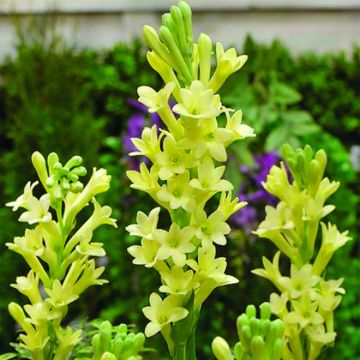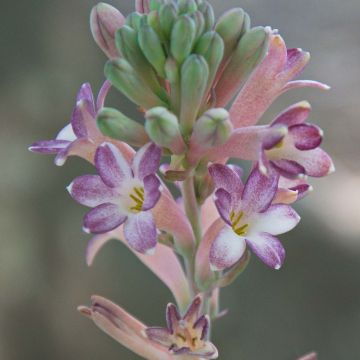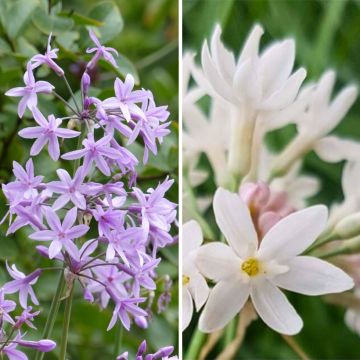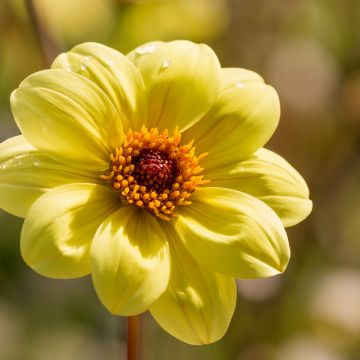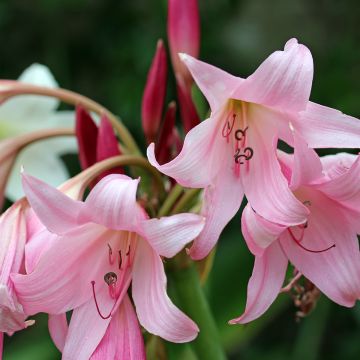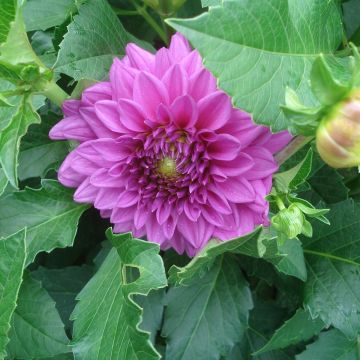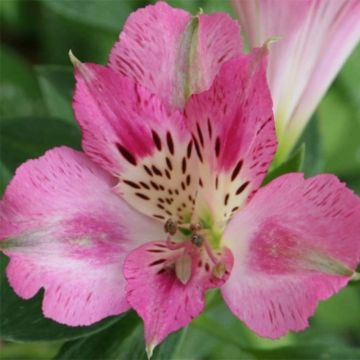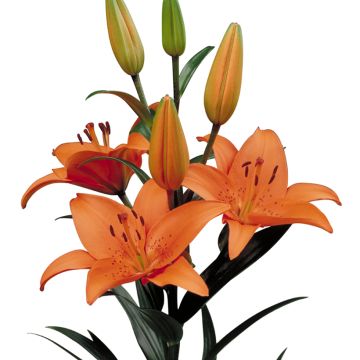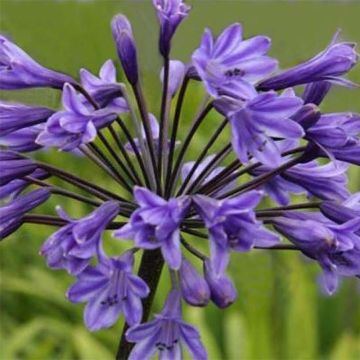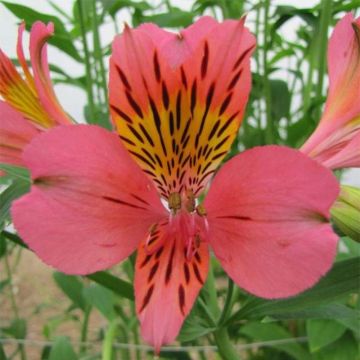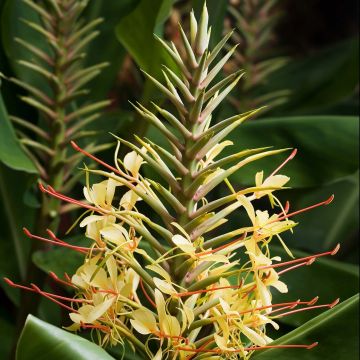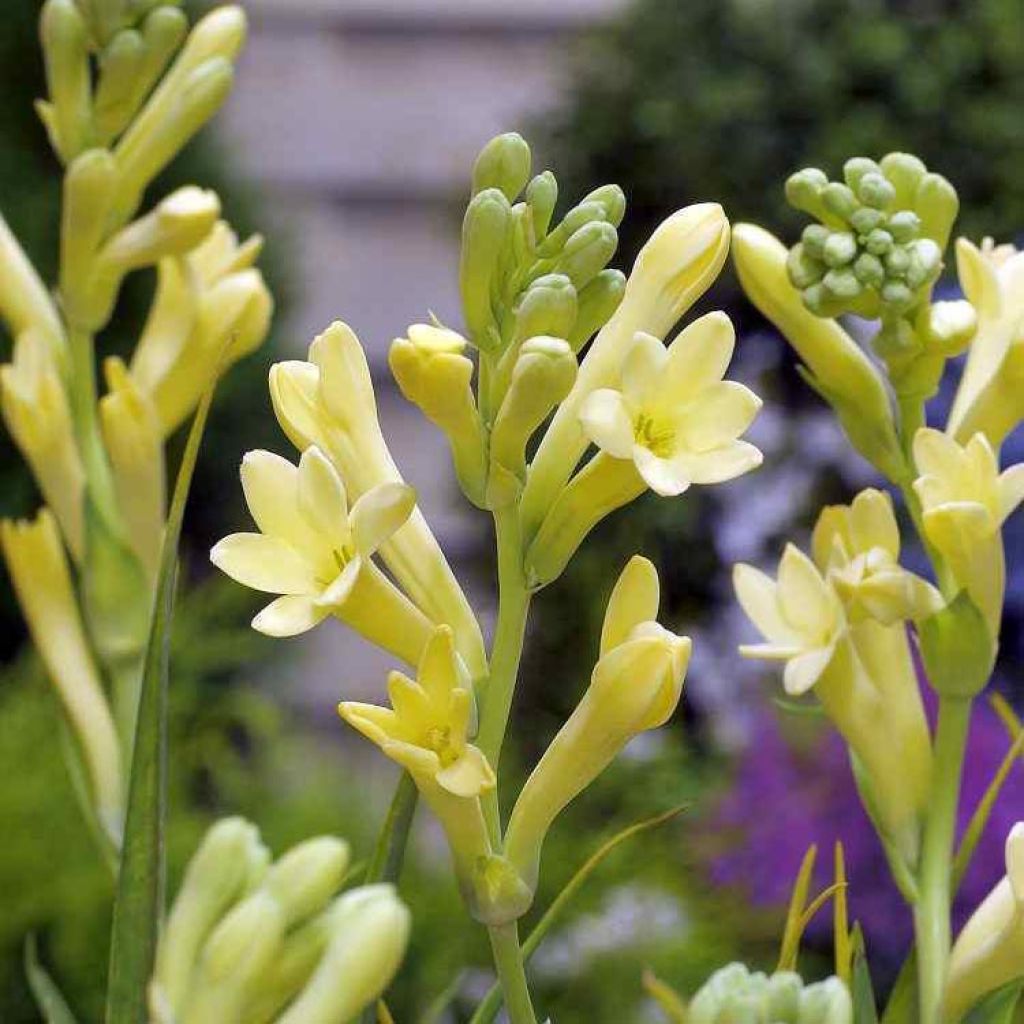

Polianthes tuberosa Yellow Baby - Tubéreuse simple jaune pâle.
Polianthes tuberosa Yellow Baby
Polyanthes tuberosa Yellow Baby
Tuberose
I've already planted them, we'll see.
Irina G., 31/03/2018
This plant carries a 6 months recovery warranty
More information
We guarantee the quality of our plants for a full growing cycle, and will replace at our expense any plant that fails to recover under normal climatic and planting conditions.
From €5.90 for pickup delivery and €6.90 for home delivery
Express home delivery from €8.90.

Does this plant fit my garden?
Set up your Plantfit profile →
Description
Polianthes tuberosa 'Yellow Baby' is a new hybrid tuberose, distinguished by its short flowering stems that do not require staking, as well as its single flowers, unique in their funnel shape and very pale lemon yellow colour. As fragrant as those of its famous cousin 'La perle', they fill the air with their unmistakable scent, especially in the evening. This early variety with a long summer flowering period is an excellent plant for sunny borders in mild climates. Elsewhere, it can be grown in pots that are stored dry in winter.
Polianthes tuberosa is native to Mexico, particularly the surroundings of Mexico City, which has a subtropical climate without frost, characterised by a dry season from November to May, and a rather rainy summer season (from June to mid-October). This plant is becoming rare in its natural environment and generally grows in sandy but humus-rich, well-drained soils. These data allow us to adapt the cultivation methods that should be applied under our climates.
'Yellow Baby' is a recent horticultural hybrid, obtained at the University of Taiwan. This cultivar is derived, among others, from Polianthes tuberosa 'La Perle' and Polianthes howardii, a robust, floriferous Mexican species with tubular flowers of variable colour. All these plants belong to the agavaceae family (or asparagaceae according to classification). They are semelparous tuberous perennials, which means that each plant only flowers once, having ensured its offspring by producing several small tubers that will flower two to three years later. 'Yellow Baby' develops a basal rosette of long, narrow, flat, deciduous, light green leaves. They can measure up to 30 cm (12in) long and 1 cm (0in) wide. Flowering occurs from June to September. From the centre of the rosett, flowering stems emerge and reach a height of 40 to 50 cm (16 to 20in). They bear a spike composed of dozens of creamy yellow flowers, tinged with pale lemon. These gradually open from bottom to top and form narrow, waxy-looking trumpets that curve backwards to form a small star-shaped cup. Their very powerful scent is present both day and night, and also lingers for some time if you cut them and display them in a vase.
Tuberose plants therefore prefer bright and warm environments, are sensitive to frost, and do not appreciate cold weather. Few of us will be able to grow them in the ground and will have to dig them up anyway to keep them dry and at a minimum of 10°C (50°F) during winter. Growing them in pots will be easier and allow them to be placed in the sun or in the conservatory, in an atmosphere that will reveal their powerful fragrance. The luckiest among us will be able to grow them in the ground in a small bed or rockery, against a backdrop of catmints for example, near the terrace to fully enjoy their beauty and exceptional perfume. Polianthes tuberosa is now cultivated in India for the cosmetics and perfumery industry. Its unique fragrance is used in the composition of several great perfumes.
Report an error about the product description
Polianthes tuberosa Yellow Baby in pictures
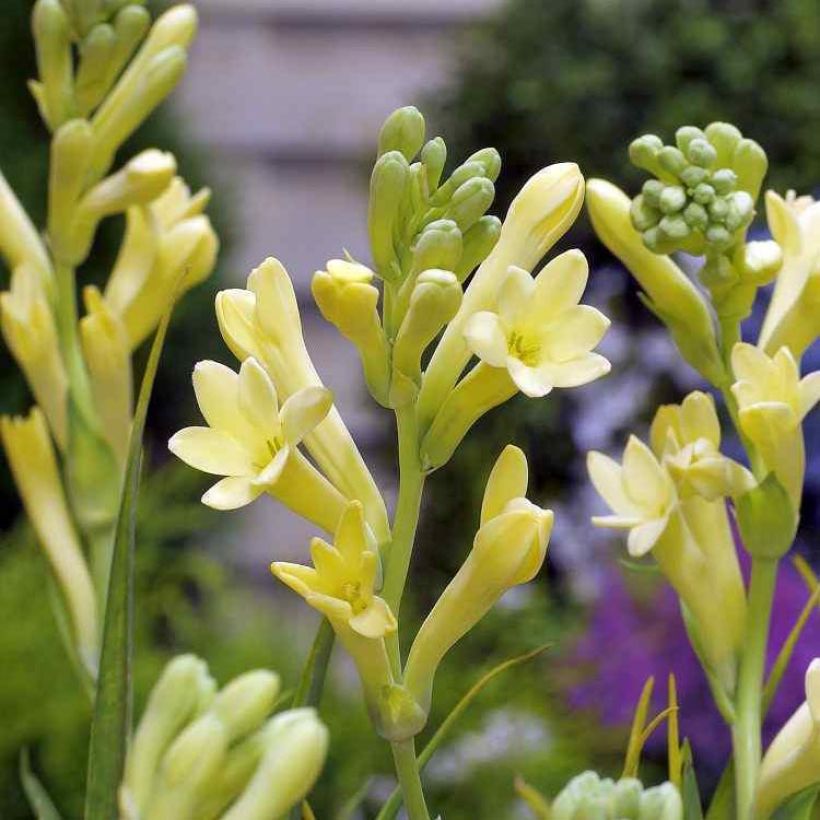

Plant habit
Flowering
Foliage
Botanical data
Polyanthes
tuberosa
Yellow Baby
Agavaceae (Asparagaceae)
Tuberose
Cultivar or hybrid
Other Polianthes - Tuberose
Planting and care
In regions with a warm climate, you can plant Polianthes tuberosa in early spring, when the soil is already warmed up (10/15°C (50/59°F)). Choose a very sunny location as they need warmth to bloom. Choose well-drained soil, enriched with sand and leaf compost, and plant them 10 cm (4in) deep, spaced 10 to 30 cm (4 to 12in) apart. Dig up the clumps before the first frost, let them dry for a few days, and store them in sand, protected from frost and kept at a temperature above 10°C (50°F). You may find bulblets at the periphery of the main bulb. Gently remove them and put them in pots for the following season. However, they will not flower in the first year.
Pot cultivation (recommended in most of our regions): To achieve earlier flowering, bulbs can be brought into growth in pots and taken outside in April (if temperatures reach around 15°C (59°F) during the day). Tuberoses can be planted in large pots with a diameter of 25 to 30 cm (10 to 12in) for one bulb, and 3 bulbs per pot with a diameter of 40 to 50 cm (16 to 20in). The pots will be brought indoors in winter until the following April.
Planting period
Intended location
Care
-
, onOrder confirmed
Reply from on Promesse de fleurs
Bulbs to grow in pots
Haven't found what you were looking for?
Hardiness is the lowest winter temperature a plant can endure without suffering serious damage or even dying. However, hardiness is affected by location (a sheltered area, such as a patio), protection (winter cover) and soil type (hardiness is improved by well-drained soil).

Photo Sharing Terms & Conditions
In order to encourage gardeners to interact and share their experiences, Promesse de fleurs offers various media enabling content to be uploaded onto its Site - in particular via the ‘Photo sharing’ module.
The User agrees to refrain from:
- Posting any content that is illegal, prejudicial, insulting, racist, inciteful to hatred, revisionist, contrary to public decency, that infringes on privacy or on the privacy rights of third parties, in particular the publicity rights of persons and goods, intellectual property rights, or the right to privacy.
- Submitting content on behalf of a third party;
- Impersonate the identity of a third party and/or publish any personal information about a third party;
In general, the User undertakes to refrain from any unethical behaviour.
All Content (in particular text, comments, files, images, photos, videos, creative works, etc.), which may be subject to property or intellectual property rights, image or other private rights, shall remain the property of the User, subject to the limited rights granted by the terms of the licence granted by Promesse de fleurs as stated below. Users are at liberty to publish or not to publish such Content on the Site, notably via the ‘Photo Sharing’ facility, and accept that this Content shall be made public and freely accessible, notably on the Internet.
Users further acknowledge, undertake to have ,and guarantee that they hold all necessary rights and permissions to publish such material on the Site, in particular with regard to the legislation in force pertaining to any privacy, property, intellectual property, image, or contractual rights, or rights of any other nature. By publishing such Content on the Site, Users acknowledge accepting full liability as publishers of the Content within the meaning of the law, and grant Promesse de fleurs, free of charge, an inclusive, worldwide licence for the said Content for the entire duration of its publication, including all reproduction, representation, up/downloading, displaying, performing, transmission, and storage rights.
Users also grant permission for their name to be linked to the Content and accept that this link may not always be made available.
By engaging in posting material, Users consent to their Content becoming automatically accessible on the Internet, in particular on other sites and/or blogs and/or web pages of the Promesse de fleurs site, including in particular social pages and the Promesse de fleurs catalogue.
Users may secure the removal of entrusted content free of charge by issuing a simple request via our contact form.
The flowering period indicated on our website applies to countries and regions located in USDA zone 8 (France, the United Kingdom, Ireland, the Netherlands, etc.)
It will vary according to where you live:
- In zones 9 to 10 (Italy, Spain, Greece, etc.), flowering will occur about 2 to 4 weeks earlier.
- In zones 6 to 7 (Germany, Poland, Slovenia, and lower mountainous regions), flowering will be delayed by 2 to 3 weeks.
- In zone 5 (Central Europe, Scandinavia), blooming will be delayed by 3 to 5 weeks.
In temperate climates, pruning of spring-flowering shrubs (forsythia, spireas, etc.) should be done just after flowering.
Pruning of summer-flowering shrubs (Indian Lilac, Perovskia, etc.) can be done in winter or spring.
In cold regions as well as with frost-sensitive plants, avoid pruning too early when severe frosts may still occur.
The planting period indicated on our website applies to countries and regions located in USDA zone 8 (France, United Kingdom, Ireland, Netherlands).
It will vary according to where you live:
- In Mediterranean zones (Marseille, Madrid, Milan, etc.), autumn and winter are the best planting periods.
- In continental zones (Strasbourg, Munich, Vienna, etc.), delay planting by 2 to 3 weeks in spring and bring it forward by 2 to 4 weeks in autumn.
- In mountainous regions (the Alps, Pyrenees, Carpathians, etc.), it is best to plant in late spring (May-June) or late summer (August-September).
The harvesting period indicated on our website applies to countries and regions in USDA zone 8 (France, England, Ireland, the Netherlands).
In colder areas (Scandinavia, Poland, Austria...) fruit and vegetable harvests are likely to be delayed by 3-4 weeks.
In warmer areas (Italy, Spain, Greece, etc.), harvesting will probably take place earlier, depending on weather conditions.
The sowing periods indicated on our website apply to countries and regions within USDA Zone 8 (France, UK, Ireland, Netherlands).
In colder areas (Scandinavia, Poland, Austria...), delay any outdoor sowing by 3-4 weeks, or sow under glass.
In warmer climes (Italy, Spain, Greece, etc.), bring outdoor sowing forward by a few weeks.

































